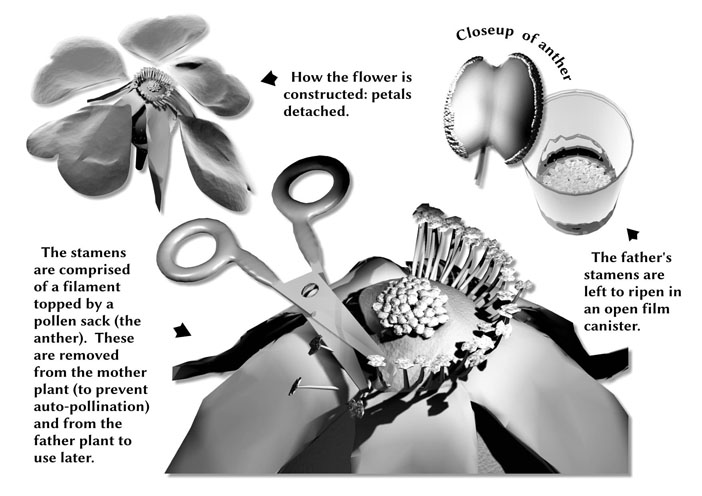|
For the amateur breeder as well as the scientist, the idea of creating a new hybrid justifies all the efforts that precede the eventual flowering of the new plant,
often many years after the crossing: thorough techniques and patience are therefore prerequisites.
Observation and the choice of the parents are key elements for the success of any cross.
The result of a cross is indeed expected by the breeder according to his knowledge in genetics and heritable traits from parents, as shown by the records of Felicitas Svejda.
Mr. Ivan Louette, creator of the botarosa.org website, from Belgium, has graciously allowed us to use his beautiful plates that illustrate the four stages of hybridization.
Rose hybridization in four steps: First step
Male parent:
The pollen for the cross must be taken from the male parent two days before the petals unfold. Pollen is kept in a glass or a plastic container, labeled with the date and the name of the pollen parent (male parent).
The container is put in the fridge, still opened, to allow humidity to escape, and permit the anthers (stamens) to dry. After two days or more, the anthers will burst and discharge the pollen. Shaking the container gently allows to see if the pollen is free. If so, it will coat the inside of the container.
Female parent:
The flowers that will bear the fruits are selected as they start to unfold. Their petals are carefully removed
a day before the cross is made. The stamens are removed with small scissors (stamens can be retained for later use, in closed glass or plastic containers in the refrigerator).
A small bag (polyethylene, paper or tissue) is placed on the gynoecium (female member) to protect it from accidental floating pollen or pollination by insects or pollen.
Some say that insects are not attracted by a flower without petals or stamens, but why take a chance? A coded label is attached to the flower to identify it as a seed parent.

|



